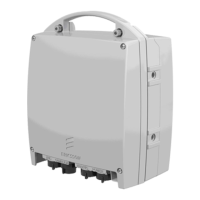MINI-LINK BAS 2-2
Technical Description EN/LZB 111 0542 P2B
2.1 Overview
The MINI-LINK BAS integrates ATM transport and microwave
broadband technologies. This permits the system to efficiently use the
carrier bandwidth to support a wide range of medium to high-speed
services. It is a complete end-to-end solution from customer service
terminals, to IP/ATM/PSTN backbone equipment and management
systems. It assures the quality, availability and security that Ericsson
customers have come to depend on for over a century.
The MINI-LINK BAS consists of customer located Access
Terminations (ATs), communicating with Radio Nodes (RNs).
User traffic is either transported to the customer premises through a
dedicated point-to-point connection, for longer radio reach, or in a
point-to-multipoint configuration. The latter provides an efficient use
of available spectrum sharing the air interface capacity among many
customers and allowing the use of statistical multiplexing over the
radio interface.
The system communicates with ATM and PSTN backbones via a
variety of standard interfaces, from E1/T1 to OC-3/STM-1, 155 Mbps.
ATs support a wide variety of services, from PBX interconnections to
LAN to LAN interconnect and Internet access over different types of
interfaces such as E1/T1 and Ethernet 10/100BaseT.
The customer located ATs are designed with “hot plug-in” service
interface boards for different service requirements. So new services
are easily added without any impact on other services. ATs are also
designed with remote program capability so that settings can be
changed without the need for a visit from a service engineer at the
customer premises.
The MINI-LINK BAS utilises a Constant envelope offset-Quadrature
Phase Shift Keying/Time Division Multiple Access/Frequency
Division Duplex (C-QPSK/TDMA/FDD) scheme.
C-QPSK is a robust modulation scheme that delivers exceptional
Carrier to Interference (C/I) performance and a healthy link budget
that is required in a fully built out system.
The TDM/TDMA solution allows to efficiently support the fast
dynamics in bursty packet switched data networks (IP traffic) via
statistical multiplexing and F-DCA. This results in a very compact and
cost effective solution.
The MINI-LINK BAS uses applicable frequency spectrum such as:
• 24.5-26.5 GHz band in Europe
• 27.5-28.35 GHz in the US LMDS “A” band
• 31.0-31.30 GHz in the US LMDS “B” band

